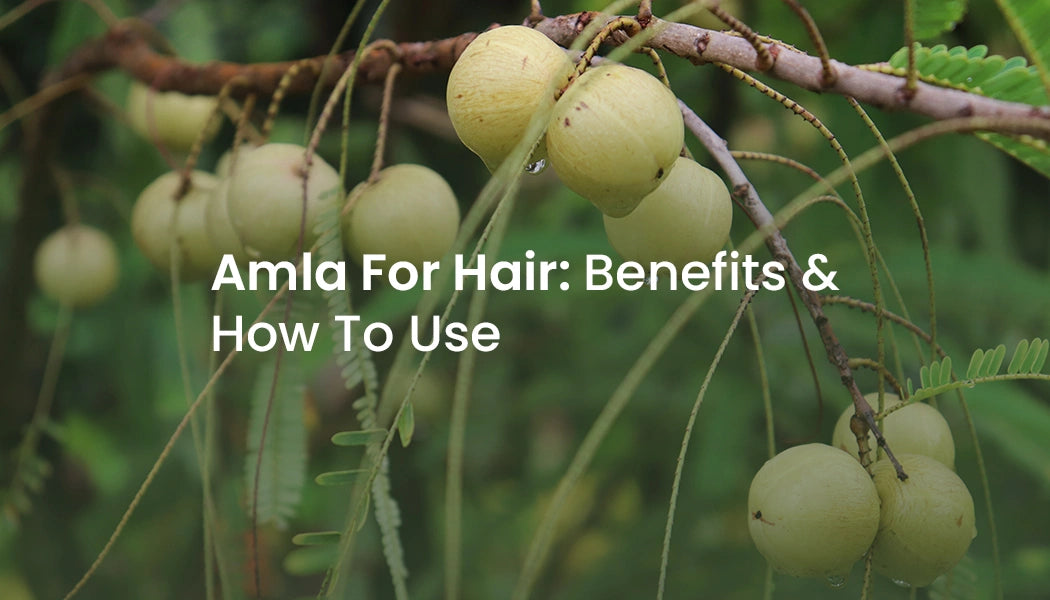
Amla For Hair: Benefits & Usage
Amla For Hair: Benefits And How To Use
We all know that Amla is extremely good for our health, but are you aware of the benefits of Amla for hair? Commonly known as Amla in India, the Indian gooseberry has many healing properties and has been used for centuries to treat various ailments. In this blog post, we’ll look at the Amla benefits for hair, including how it can promote hair growth and prevent hair fall. We’ll also explore some tips on how to use it effectively so you can get the most out of this natural remedy.
Benefits Of Using Amla For Hair
According to Ayurveda, our body is governed by three doshas-Vata, Pitta, and Kapha. Any dosha that exceeds its normal range or transfers to a place where it is not needed creates an imbalance and causes hair loss. Amla is a fruit that balances all three doshas in our bodies, particularly Pitta dosha. Amla is a natural source of Vitamin C and antioxidants, as well as being high in iron content, making it a crucial ingredient in Ayurvedic hair care products. Regular consumption of amla helps to prevent hair loss, promote hair growth, and make your hair thicker and stronger. There are various ways to use amla for hair. You can use amla oil for scalp massage, or make a paste with amla powder and water to use as a hair mask.
Here are some benefits of using amla for hair:
- Amla promotes hair growth
- Amla strengthens the roots of your hair
- Amla makes your hair thicker and shinier
- Amla prevents premature greying of hair
- Amla treats dandruff and other scalp conditions
- Amla can help balance a flaky scalp
- Amla improves hair quality
Effective Ways of Using Amla On Hair
Amla has been used for centuries to treat a variety of conditions. Amla can rehydrate your hair’s volume and shine. It effectively removes dead and split ends from your hair while adding a beautiful shine. Amla has the highest vitamin C content. Antioxidant properties of vitamin C can help balance out free radicals that contribute to oxidative stress. Hair loss, damage, premature ageing, and greying are all caused by oxidative stress.
Amla Oil has been used extensively in Indian haircare rituals since ancient times, to nourish the scalp and grow stronger hair. This oil was traditionally made by sun-drying amla and then cooking them in coconut oil to extract all of its nutrients. Amla benefits for hair are truly endless, ranging from preventing hair loss and premature greying to conditioning dry, damaged hair. There are many ways to use amla for hair, but some of the most effective methods include
Amla Oil:
Amla oil is made by extracting the oil from the amla. The Scalp oil massage helps to improve circulation and encourage hair growth.
Amla Powder:
Amla powder can be mixed with water or curd to create a paste that can be applied to the scalp and hair. Leave the paste on for 20-30 minutes before washing it off. Use this treatment 2-3 times per week for the best results. This paste will help to exfoliate the scalp, remove build-up, and stimulate hair growth.
Amla Juice:
Fresh amla juice can be applied directly to the scalp for an extra boost of nutrients. The high vitamin C content in amla juice helps to strengthen the hair shafts, prevent breakage and promote glowing skin. Amla/Gooseberry juice can help your skin age more slowly. This drink is high in antioxidants, which can help your skin look younger and fight ageing cells. Drinking amla juice on a regular basis helps to prevent premature ageing, fine lines, dark spots, and wrinkles.
Read Also: Hibiscus for Hair Growth: Benefits & How to Use
Amla For Hair Growth
Amla is rich in antioxidants, vitamins C and E, and minerals such as iron and copper. Amla contains vitamin C, phosphorus, calcium, iron, beta-carotene, fibre, vitamin B, and protein. All of these vitamins are essential for hair health. These nutrients help to nourish the hair follicles and promote hair growth.
Amla also has anti-inflammatory properties that can help to reduce scalp inflammation and dandruff. Amla is a nutrient-rich fruit that is frequently used in hair care. Its antioxidant and anti-inflammatory properties make it ideal for treating a variety of hair problems. While ayurvedic oil and hair masks are commonly used to improve hair health, amla juice can also be consumed on a daily basis. Consuming amla will provide your body with the nutrients it needs to support healthy hair growth from the inside out.
How To Eat Amla For Hair Growth
Amla is one of the best ingredients that you can use for your hair. It contains vitamin C, which is crucial for hair growth. Amla also contains other nutrients such as iron, calcium, and magnesium, which are all important for healthy hair. Amla is rich in antioxidants, which help to protect the hair from damage and keep it looking healthy. Additionally, amla is a great source of vitamin C, which helps to promote collagen production and keep the hair follicles strong. Furthermore, Amla is known to promote hair growth and prevent premature greying. Amla can be consumed in a number of different ways. Here are a few tips.
- Raw Amla: Amla contains antioxidants, which aid in the removal of harmful free radicals from the body and keep the hair free of dandruff, dryness, and irritation. Eat one raw amla every day for three months to promote hair growth. Amla contains 600 to 700 mg of vitamin C per serving. You can season it with salt or honey to taste.
- Amla juice: Drinking two tablespoons of amla juice on an empty stomach once a day helps to maintain overall health. To use amla for hair growth, you can either eat it raw or make a paste out of it. If you choose to eat it raw, simply take a few amla fruits and eat them with water. If you prefer to make a paste out of amla, then grind the fruits into a powder and mix it with water to form a thick paste. Apply this paste onto your scalp and leave it on for 30 minutes before washing it off. For best results, follow this 2-3 times per week.
Amla is known to be a powerful herb that can help promote hair growth and prevent hair loss. Amla is rich in antioxidants, which help protect the scalp from damage and strengthen the roots of the hair. It also contains vitamin C, which helps increase collagen production and promote blood circulation in the scalp. Regular consumption can help fight dandruff and other scalp issues, making your hair look healthy and shiny.
Amla is best consumed early in the morning, preferably on an empty stomach. Amla contains a lot of fibre, which can cause gastrointestinal and constipation problems. Hence consume it in moderation. In this article, we will discuss how to eat amla for maximum benefit so you can get healthy and strong hair naturally. We will also talk about some Ayurvedic products that you can use alongside amla for even greater results.
Conclusion
Amla miraculously transforms your hair, making it longer, thicker, and more lustrous. Indian gooseberry is a great natural remedy for treating hair problems. It can help with strengthening and nourishing the hair, preventing premature greying, controlling dandruff and providing protection against environmental damage. Amla is an incredible fruit that offers a plethora of benefits for hair. Finally, amla oil is an excellent natural hair conditioner that can help to make the hair soft, shiny, and manageable.
The best way to use this amazing ingredient is by taking advantage of its various forms – powders, oils or juices. We hope that you found our article helpful in understanding how Amla/ Indian gooseberry can benefit your hair and how you can incorporate it into your daily routine.

